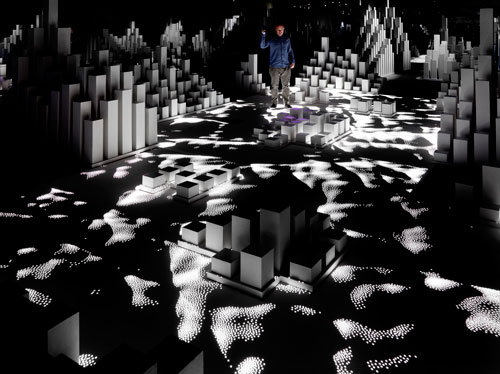

National Maritime Museum Greenwich, London
14 July 2011–13 January 2012
by MK PALOMAR
It is this danger of unawareness that High Arctic at the National Maritime Museum forcefully addresses. “Intended to be a future vision of a receding world, it encourages us to question our relationship with the world around us.” In September 2010 United Visual Artist’s Matt Clark travelled with the arts and climate science foundation, Cape Farewell, to the archipelago of Svalbard (between mainland Norway and the North Pole).2 At this point the author must admit to having visited the Arctic (the Canadian Northwest Territories and the Russian/Norwegian Svalbard) in the 1980s, knowledge of that most Northern latitude, has seeped into her senses and she cannot be impartial to this subject. The open land without buildings roads or trees – visual reference points, disrupts the reading of scale and distance. And the 24-hour sun that glows in a constant afternoon light, confuses the Kadlunak’s body clock – (an Inuit name for southern visitors meaning people with low eyebrows)3, contributing to the sense of dislocation and to the dreamlike experience of ice land and sea.
While the Arctic affords us an intense phenomenological experience, the eroded condition of its glaciers and sea ice4 displays that our desire to experience, to consume, has severely impacted the environment. Pushing through a black curtain into High Arctic, with the sound-scape5 of ice against ship’s hull and wind over water, ultraviolet torchlight leads the viewer along a wooden deck, tracing backwards through Arctic histories. Passing Matthew Henson (1909 – African American navigator for Admiral Peary), Saint Brendan (530 AD) we arrive at the 4th century BC when Pytheas of Massilia the Greek explorer “… sailed with the sun into a dream... where the sun did not stop and the water congealed”. Believed to be a pretender this early explorer’s experiences were too extraordinary for his countrymen to comprehend. “When at last I returned home they did not believe me – I wrote the truth in a book but the book was lost I am Pytheaus the Greek this was my dream.”6 Sitting in Matt Clark’s dimly lit (“...immersive, responsive) environment”7 voices tell us stories “... arctic explorers and the poetry of Nick Drake, (who travelled with Clark to Svalbard)”.8 Clark has constructed “... an archipelago of thousands of columns … each representing a real glacier in Svalbard”.9 The torch light reveals their names Venernbreen, Osbornebreen, Olsokbreen … clusters of columns are interspersed with responsive floors, mesmerising light shows triggered by motion. A contour map of the land that flies underfoot, knocking the viewer off balance, a snow storm of light flakes pushed by the torch light, puddles of light pressed dark by foot fall – this brilliant interactive display echoes Arctic experiences of snow ice and physical dislocation.
Outside the gallery the LCD screen shows Cape Farewell’s crew on a boat with a crescent moon, playing an accordion on an ice floe, and tramping across the snow. This exhibition is just the tip of Cape Farewell’s astonishing enterprise intent to wake us up from our sleepwalking. And lest we like Pytheaus’s countrymen, continue not to comprehend our relationship to the world, Director of Cape Farewell David Buckland succinctly reminds us, “It’s the way we live that causes climate change”.10
References
1. Rule Britannia, (...Britannia rules the waves Britain’s never ever, ever will be slaves). Written by Scottish poet James Thompson (1700-1748) and put to music by English composer Thomas Arne (1710-1778).
2. Maritime Museum press release.
3. Kari Herbert, The Explorers Daughter: A young Englishwoman rediscovers her Arctic Childhood, London, Viking 2004.
4. In conversation with recently retired Polar Pilot Karl Zberg, Zberg confirmed that finding ice floes strong enough to land his airplane on had become progressively difficult. In the 1980’s he might have looked for a landing floe for some minutes, but in the 1990’s he had to search for hours before finding a strong enough floe to land on. Dea Birkett describes Zbergs polar experiences in her 2003 Guardian article. http://www.guardian.co.uk/lifeandstyle/2003/feb/01/weekend.deabirkett
5. by Max Eastley and Henrik Ekeus.
6. Transcribed from the exhibition sound-scape and poetry of Nick Drake.
7. Maritime Museum press release.
10. http://www.capefarewell.com/
